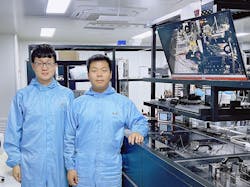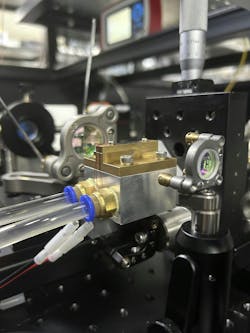Researchers demo diamond-based Raman vortex beams
Inspired by the rapid evolution and broad applications of vortex beams, an international team of researchers from China, Japan, and Australia set out to address a few challenges of traditional population inversion lasers—namely limitations in wavelength scalability and power scaling.
Drawing upon their earlier work with diamond-based lasers, the researchers realized diamond’s exceptional thermo-optical properties could offer a breakthrough solution (see video).
On one hand, “diamond stands out with the highest thermal conductivity among known crystals, which not only promises a significant power improvement through efficient heat management but also minimizes thermal distortions at high power levels,” says Zhenxu Bai, a professor of optics, vice dean of the School of Electronics and Information Engineering, and deputy director of the Center for Advanced Laser Technology & Hebei Key Laboratory of Advanced Laser Technology and Equipment at Hebei University of Technology in China.
Over on the other hand, “as a Raman gain medium, diamond provides the largest Raman frequency shift coupled with a remarkably high gain coefficient,” Bai says. “These features enable precise wavelength tuning and high conversion efficiency, which are critical for advancing vortex beam technology. We found the prospect of harnessing diamond’s superior thermal and optical characteristics to enhance vortex beam performance particularly compelling—paving the way for innovative applications within fields ranging from optical manipulation and high-resolution imaging to quantum optics.”
Diamond-based Raman vortex beams
Diamond is a critical nonlinear medium that enables laser output through intense pumping to trigger nonlinear effects such as stimulated Raman scattering (SRS) and stimulated Brillouin scattering (SBS).
“When designing diamond-based lasers, it’s essential to ensure the diamond crystal receives sufficient pump intensity and the pump beam is precisely mode-matched to the laser cavity’s intrinsic modes,” explains Bai. “This alignment is particularly crucial for diamond Raman vortex lasers, where optimal gain extraction and a minimized lasing threshold depend on selecting the cavity mode that best matches the pump mode.”
The team’s experimental method builds upon conventional techniques in diamond lasers and vortex beam generation, but combines them in a new way. They integrate a simple vortex beam generation approach—off-axis pumping—with a traditional diamond Raman oscillator.
“By deliberately rotating the output mirror of a collimated diamond Raman oscillator at a precise angle, we enhanced the mode overlap between the higher-order Raman modes to control the oscillation process and generate vortex beams in both first-order and cascaded-order Raman,” says Bai. “Notably, with a 1-micron pump, our setup produced vortex beam outputs at 1.2 and 1.5 microns—wavelengths that align with excellent transmission windows. This marks the first reported case of achieving vortex rotation at these wavelengths with this method.”
One of the main challenges the team faced was to improve the efficiency of Raman-based vortex beam generation. Raman conversion demands high pump intensities and precise mode-matching conditions, and the inherent high-order transverse mode distribution tends to reduce laser power density and complicate the matching process.
“In our study, we manually adjusted the experimental parameters,” says Hui Chen, a Ph.D. candidate at Hebei University of Technology. “But we believe using precise control systems will optimize the conversion efficiency and pave the way for low-threshold, high-power vortex beam generation.”
What does this mean now for Raman lasers? “It’s a breakthrough for Raman vortex lasers,” Bai says. “Traditionally, vortex light in Raman laser research is generated using vortex light as the pump source. But our work demonstrates that a Gaussian beam pump can produce vortex rotational output directly via Raman oscillators. While our initial demonstration used diamond, we believe this method has potential to be extended to any Raman crystal. This approach not only simplifies the generation of vortex beams but also broadens the horizon for future developments in both Raman lasers and vortex beam technology.”
Simplified approach for generating vortex lasing
One of the most thrilling moments for the team was “discovering a simplified approach for generating vortex lasing at special wavelengths,” says Bai. “By leveraging a traditional Gaussian beam pump, we directly achieved specific—and even multiwavelength—vortex beams via Raman conversion.”
Fine-tuning the off-axis angle allows them to seamlessly transition between the Gaussian base mode, Hermite-Gaussian (HG) mode, and Laguerre-Gaussian (LG) mode, which results in high-quality beam modulation.
“In our experiments, we demonstrated first-order and cascaded vortex optical outputs delivering up to tens of watts,” Bai says. “Coupled with the exceptional thermal and optical properties of diamond, our diamond Raman lasers unlock the unprecedented control and flexibility to generate high-power vortex light—and herald a new era of laser beam manipulation.”
Materials processing and optical comms applications ahead
One of the key advantages of diamond-based vortex beams is their exceptional wavelength versatility and power scaling ability. “Thanks to diamond’s broad spectral transmission range, its Raman frequency shift characteristics, and the wavelength-independent nature of vortex beam generation, the operational wavelengths of vortex beams can be significantly expanded,” says Bai. “This breakthrough opens up exciting opportunities in materials processing, where vortex beams at different wavelengths can be optimized for a variety of applications.”
Generating multiwavelength vortex beams also holds promise to enhance optical communication and quantum information systems by boosting data transmission rates and overall efficiency. “With the ongoing maturation of artificial optical-grade diamond crystal growth technology and the gradual reduction in diamond costs, the overall expenses associated with diamond lasers are expected to decrease,” says Bai. “As a result, within the next three to five years, diamond Raman vortex lasers may drive forward industrialization and revolutionize both manufacturing processes and optical communications.”
Diamond vortex rotation
The parameters for controlling diamond vortex rotation involve not only spatial distribution but also coherence, which is crucial for future long-distance space detection applications. “We want to further integrate the distinctive properties of diamond lasers into vortex beams by leveraging features such as narrow linewidth, specialized wavelength generation, high power output, and superior beam quality,” says Bai.
Diamond is also an ideal medium for Brillouin gain. “In 2020, we measured the Brillouin gain coefficient of diamond crystals and achieved direct high-power Brillouin laser emission,” Bai adds. “So we’re now exploring the generation of Brillouin vortex beams within diamond—a development that could extend vortex rotation into the realm of millimeter-wave frequencies.”
FURTHER READING
H. Chen et al., ACS Photonics, 12, 2, 864–869 (2025); https://doi.org/10.1021/acsphotonics.4c01852.
About the Author
Sally Cole Johnson
Editor in Chief
Sally Cole Johnson, Laser Focus World’s editor in chief, is a science and technology journalist who specializes in physics and semiconductors.


